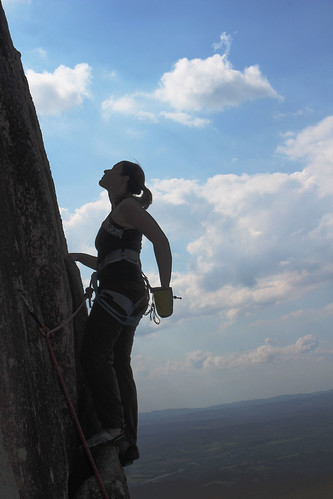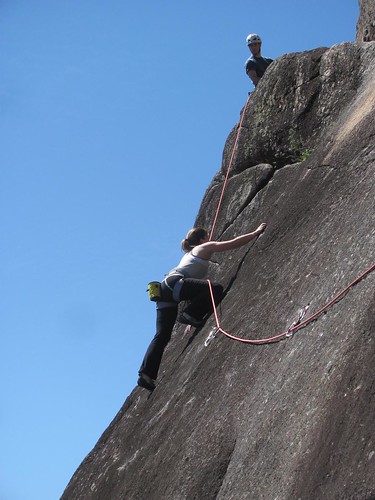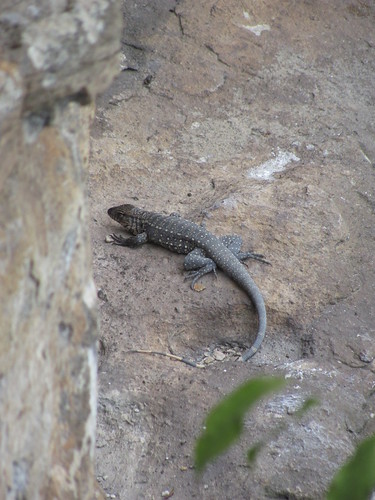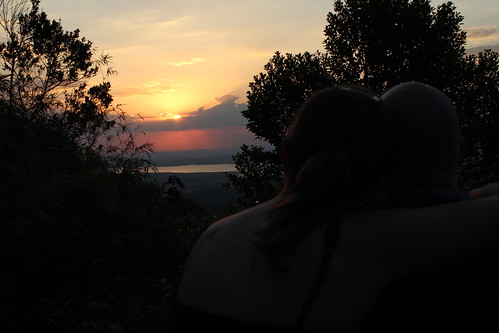 |
Looking out toward Curitiba
(Photo by Nivea Bona) |
When I first landed in South America in December of 2010, I settled in Santiago de Chile, the Chilean capital city so walled in by the giant Andes mountain range to the east that peaks often felt as if they’d topple right down on top of the city. I chose to live in Chile in part due to the quality and abundance of climbing there. But as the world turns so does life move on, and upon meeting a great girl from the other side of the continent, I decided to relocate to southern Brasil, where I had no clue if there were even mountains let alone crags worth visiting.
 |
Second Lead Ever
(Photo by Nivea Bona) |
Ten weeks removed from moving to Brasil, I realize that not only is Brasil not just a country with great beaches, but the climbing here is every bit as spectacular as it is anywhere else I’ve visited. No, I haven’t visited the great destinations around Rio de Janeiro or Minas Gerais yet, but I have hit a couple of the areas in the southern state of Paraná, which has one of the longer histories of climbing in Brasil despite the sport’s newness here (importing gear was prohibited prior to about 1991). We’ve only really frequently climbed at one place called Anhangava (pronounced - eye-yen-GAH-va), but we also explored on a foggy, rainy day another place called Marumbi, and climbed twice at a ‘Gunks-like crag called São Luiz do Purunã.
 |
| Learning Slab |
Anhangava is sort of the sport crag in the region. It is only an hour away from Curitiba, the capital city of Paraná, and access is pretty easy. It sits atop a small mountain that requires only a 30-minute hike to the base. There are about 100 bolted routes there on the hard, seemingly-porous, and sticky granite. Even the gear routes have bolts for anchors at the top. On a sunny weekend day, due in part to the area around the mountain also being a park, hundreds of Curitibanoes flock to Anhangava to hike, picnic, or climb. Truly a relaxing place, it can also get crowded.
 |
| The Wildlife |
Marumbi, despite having the same rock as Anhangava, is world’s away from it’s sister park and crag. For one, the mountains in the park are much larger than at Anhangava and require significantly more commitment just to get to the base. The hike in is about two hours, and that’s if you can get to the train station, where the main hike begins. If one takes the train, which only arrives at 8 a.m., then one is okay, but if one drives then a high-clearance vehicle is required. Without a high-clearance vehicle the hike is an additional hour-and-a-half longer one-way. However, once one gets to the base, if alpine is the name of the game, then Marumbi offers countless opportunities spread out over six different peaks. Most of these routes are bolted, but many are not, and all require an alpine approach to climbing due to the heavy possibility of incoming weather at a moment’s notice. Retreating here isn’t just about leaving gear on the climb, it’s about ensuring one can get down below tree line before the rain hits. Even then, as we noticed on the day we went (and only managed one climb due to the frigid wind at the top), that while we were cold at the top we were also above the clouds and dry. Once we went below the tree line and the clouds we were rained on all the way back down to the station.
 |
| Beautiful Sandstone |
The final destination we have hit (but not the final that we will go to) is São Luiz do Puruná. I had seen this place from the highway four times before I finally got a chance to check it out. From the road, and from above looking down and along the ridge-line, it looks a lot like the ‘Gunks. However, it is made of bullet-hard sandstone and it isn’t as widely developed as the ‘Gunks (although there are plenty of open opportunities to develop this place, that’s for sure). It is also the home of Brasil’s first developed route called Hamburger. Appropriately it is located next to Fries. São Luiz is also mostly a traditional climbing area. Yes, it has bolts, and many of the routes require gear to go with the routes, but it’s not really a sport-climbing area. Also, the routes tend to be on the hard side, but otherwise, I’ve actually enjoyed this location more than the other two because of the opportunity to plug gear.
 |
| Getting over the Fear |
But none of this is really the story. The real story is how my hodgepodge of international climbing friends have all come together to form a group that didn’t exist prior to me arriving. Can I take credit for this group forming? No, not really. Yes, maybe I am the impetus, but my Brasilian friends "Lady" and "Rookie" jumped on the climbing train at about the time they met me and, in typical Brasilian style, they reached out to anyone and everyone they could, bringing two experienced local climbers into the fold early on ("Lost" and "Circus"). I then met "Bump", a French dude with decent sport experience and a car, in my Portuguese class. "Lady"'’s son "Shoes" also wanted to learn how to climb at about the same time we introduced an American with one year’s experience, "Alaska", to the group. Recently we added a German guy, "Alemande" (about five years of experience on everything from sport to alpine to mountaineering) and another Brasilian simply known as "Aranha" (the spider), who is another local climber of the same mold as "Circus" and "Lost". Finally, as a result of "Circus" formerly working for Cirque du Soleil, we met "Soleil" (who still works for the circus) and "Sao Luis", one of "Soleil"’s friends and a guide in São Luiz. As a result of our stunningly rapid growth, if we all go together, we now need more than one car, and sometimes three, just to get us all to the crag.
 |
In the Clouds at Marumbi
(Photo by Isa Vellozo) |
The trick to managing all these languages? Well, it’s not that easy. Some of the Brasilians speak English and none speak French or German (at least not very well). Me, "Bump", and "Alemande" speak English (all three of us to varying degrees), French (again, to varying degress), and very little Portuguese. Of course, three of the four who speak both English and Portuguese are beginner climbers, so conversations on commands, even between the experienced-in-climbing English-speakers and Portuguese-speakers (who don’t speak English), have been entertaining at best and scary at worst. But the funny thing is that the language is the same. Yes, the commands are different, and sometimes that’s not just because of the vocabulary but also the culture as well. Yet those of us who have climbed before are still able to communicate and understand each other.
 |
A chilly day above the clouds
(Photo by Isa Vellozo) |
“What’s amazing,” "Rookie" told me one day, “is how you and "Lost" can communicate even though he doesn’t speak English and you don’t Portuguese.” We surmised that it was because the language he and I were speaking was actually the same: climbing.
Another example is how "Soleil" led me wrong on a route in São Luiz. After about 15 minutes of me searching for a bolt that simply wasn’t there, "Soleil" finally spoke up and said, “I’m so sorry Greg, but I am sending you to the right too early. You must go up first and then go right. I swear, this isn’t some sort of Brasilian joke!”
 |
Excellent Climbing In Spite of the Weather
(Photo by Isa Vellozo) |
Of course we all laughed it off, but it was funny because when I got back down to the ground I told "Soleil" that in English we call his error a sandbag. He and I laughed, but oddly so did all of the other climbers near us, of which only a couple spoke English.
While the language barriers have required some adjustments, the climbing has been pretty straight forward. When it rains, we hit one of the two gyms in Curitiba, and when it’s nice we go outside. Whoever can make it goes with us, and whoever can’t hopes to meet us next time. It rains a lot here, but the spirit of climbing is definitely alive and the itch to get outside affects everyone the same.
The state of Paraná is known for rain, so not only is nearly every wekeend in jeopardy, but the routes may not be dry even on a nice day. Still, I can’t complain. I’ve been here for ten weeks and I’ve met some great people all interested in climbing as well as climbed at a few cool places with amazing views. I can only see this getting better. Rio de Janeiro here I come? I hope so.
 |
Sunset over Curitiba
(Photo by Isa Vellozo) |











2 comments:
very cool! I was just looking for crags around Curitiba, this is the best introductory post I could hope for.
Hey Remi,
If you want to get out climbing, let me know. We can exchange info.
Thanks for the read, too. Hopefully you'll get a chance to hit the rock soon.
Greg
Post a Comment